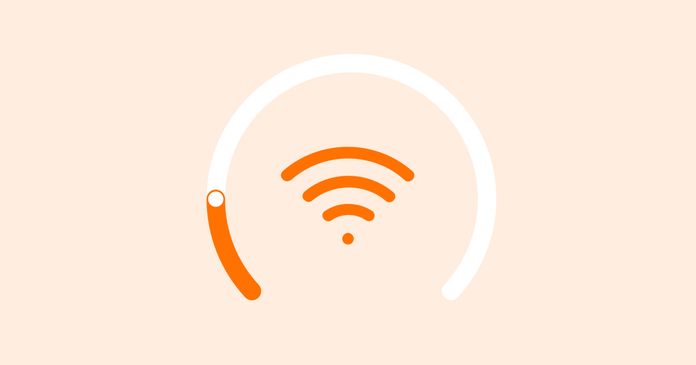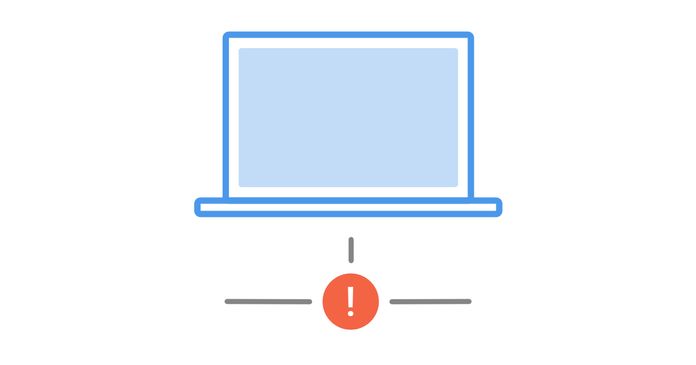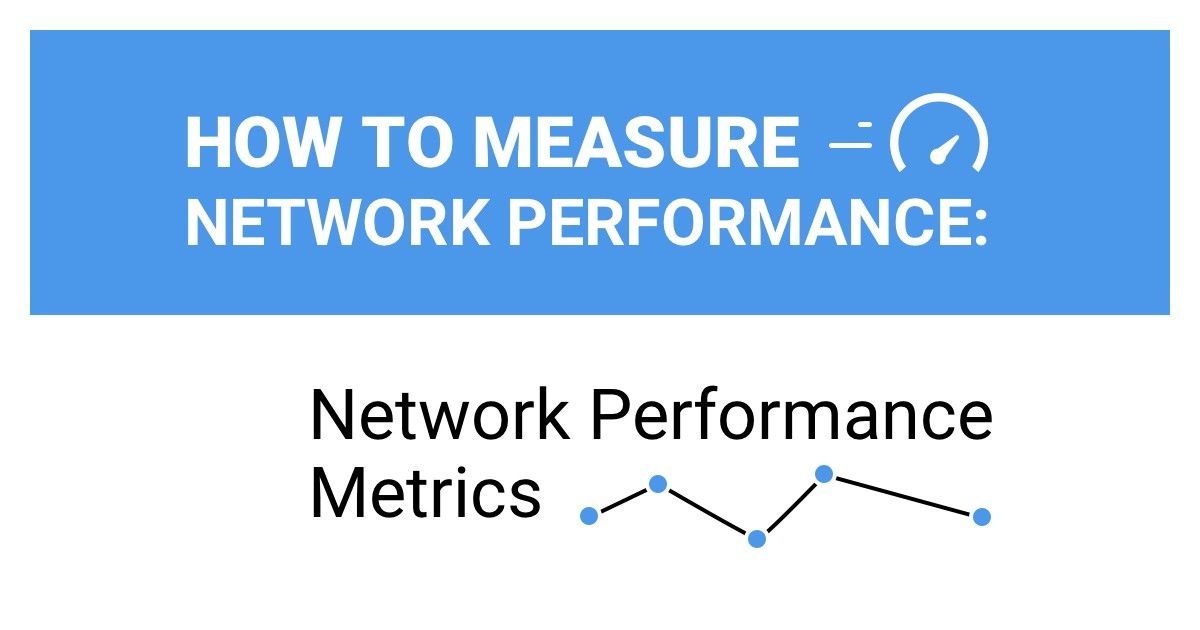Table of Contents
Table of Contents
As organizations continue to expand their digital footprint, the demand for a robust and efficient network infrastructure has surged. To navigate the complexities of today's networks, IT professionals must not only be vigilant in monitoring network usage but also adept at implementing best practices to ensure peak performance.
In this blog post, we will delve into the essential strategies and best practices that IT pros can leverage to monitor network usage effectively and, more importantly, maximize overall network performance. From cutting-edge monitoring tools to proactive optimization techniques, we'll explore the tools and tactics that will empower IT professionals to keep their networks running at peak efficiency. Let's embark on a journey to elevate your network management game and ensure that your organization's connectivity remains a pillar of strength rather than a bottleneck.
Are you ready to unlock the full potential of your network? Let's dive in.
Before we get into the nitty-gritty details of all things network usage monitoring, let’s briefly go over exactly what network usage is and why you should care about it.
Network usage refers to the amount of data transmitted over a computer network, typically measured in terms of bandwidth consumption or data transfer rates. It encompasses all the activities and communications taking place within a network, including the exchange of information between devices, applications, and users.
Here are some key aspects to consider when understanding network usage:
1. Data Transfer:
Network usage involves the transfer of data between devices connected to a network. This can include various types of data, such as files, emails, media content, and more.
2. Bandwidth Consumption:
Bandwidth is the capacity of a network to transmit data. Network usage is closely tied to bandwidth consumption, as the more data being transmitted, the higher the demand for available bandwidth.
3. Types of Network Usage:
When we talk about network usage, we usually refer to one of these usage types:
- Upload: Data sent from a local device to a remote one.
- Download: Data received by a local device from a remote one.
- Internal Communication: Communication between devices within the same network.
- Internet Access: Activities involving data transfer to or from the Internet.
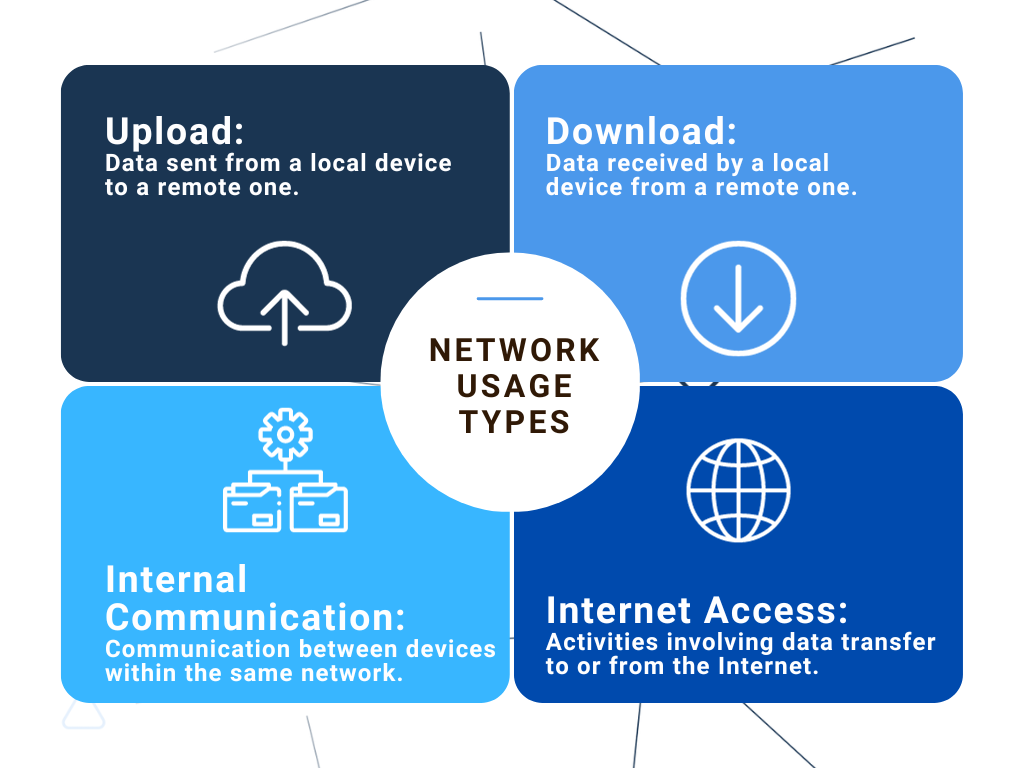

4. Applications and Protocols:
Network usage is influenced by the applications and protocols running on the network. Each application or protocol may have unique requirements and patterns of data transmission.
5. User Activity:
User actions, such as browsing the web, streaming videos, downloading files, and accessing cloud services, contribute to network usage. Monitoring user activity is essential for understanding and managing network demand.
6. Peak vs. Off-Peak Network Usage:
Network usage often fluctuates throughout the day. Understanding peak usage times helps in capacity planning and optimizing network performance during periods of high demand.
7. Security Considerations:
Monitoring network usage is crucial for identifying and responding to security threats. Unusual patterns or unexpected spikes in network traffic can be indicators of malicious activity.
8. Quality of Service (QoS):
QoS measures the performance and reliability of a network. Effective management of network usage involves implementing QoS policies to prioritize critical applications and ensure a consistent user experience.
In summary, network usage encompasses all activities related to data transfer within a network, and monitoring it is fundamental for maintaining optimal performance, ensuring security, and planning for future scalability. By understanding the nuances of network usage, IT pros can make informed decisions to enhance the efficiency and reliability of their network infrastructure.
So now we get to the part of the article where we talk about why you should care about network usage. In short, it affects your network performance as a whole.
In the intricate web of digital connectivity, the relationship between network usage and performance is pivotal for IT professionals striving to maintain a seamless and responsive infrastructure. The way data flows within a network, the applications vying for bandwidth, and the sheer volume of information transmitted—all these factors intricately shape the overall performance landscape.
Therefore, network usage influences overall network performance in different ways.
- Bandwidth Saturation:
Network performance is directly affected by the level of bandwidth saturation. When network usage approaches or exceeds available bandwidth, it can lead to network congestion, slowdowns, and potential service disruptions. Bandwidth-intensive activities, such as large file transfers or high-definition video streaming, can quickly saturate the network.
- Latency and Response Time:
Increased network usage can contribute to higher latency, which is the delay in the transmission of data between source and destination. High latency negatively impacts the responsiveness of applications and services. For real-time applications like video conferencing or online gaming, low latency is crucial for a seamless user experience.
- Packet Loss:
Intensive network usage can result in packet loss, where data packets do not reach their intended destination. Packet loss can occur due to network congestion or issues with network hardware. It can degrade the quality of voice and video communications and impact the overall reliability of data transmission.
- Quality of Service (QoS) Challenges:
Network usage patterns influence the effectiveness of QoS policies. If the network is not properly configured to prioritize critical applications, such as VoIP or business-critical software, lower-priority traffic may impact the performance of essential services.
- Security Concerns:
High network usage can create an environment where security threats are more likely to occur. DDoS (Distributed Denial of Service) attacks, for example, aim to overwhelm a network with traffic, causing disruptions. Monitoring network usage patterns is essential for identifying potential security breaches and implementing preventive measures.
- User Experience:
Ultimately, the impact of network usage is felt by end-users. A network that struggles to handle usage demands can result in a poor user experience, leading to frustration and decreased productivity. Monitoring and optimizing network performance are essential for providing users with a seamless and reliable connectivity experience.
Learn how to detect network congestion & perform a network congestion test inside & outside your network with Network Monitoring & Network Device Monitoring.
Learn more

In conclusion, understanding the impact of network usage on network performance is essential for effective network management. By closely monitoring usage patterns, implementing proactive measures, and optimizing network resources, IT professionals can ensure that their networks deliver the performance required to support the organization's objectives.
Transform the way you monitor and optimize your network with Obkio's cutting-edge Network Performance Monitoring tool. Whether you're dealing with bandwidth challenges, latency issues, or simply aiming for proactive network management, Obkio has you covered.
Gain instant visibility into your network usage and performance with real-time, continuous network monitoring. Obkio’s active monitoring solution uses synthetic traffic and strategically placed Monitoring Agents to measure network performance and proactive anticipate potential issues.

Why Obkio?
- Precision Monitoring: Obkio provides granular insights into your network, allowing you to pinpoint and address issues with precision.
- Ease of Use: With a user-friendly interface, Obkio simplifies complex network data, making it accessible to both seasoned professionals and those new to network monitoring.
- Scalability: Whether you're managing a small business network or a large enterprise infrastructure, Obkio scales to meet your needs.
Ready to unlock the full potential of your network? Sign up for Obkio's Network Performance Monitoring tool today and experience a new level of control over your network infrastructure.
Take charge of your network performance and ensure a seamless and responsive digital experience for your users. Don't let network challenges hold you back—empower your IT team with Obkio's advanced monitoring solutions.

Ever wondered how your network talks? Well, that's where understanding network usage comes into play. In this section, we're going to break down the basics: how we measure data flow, the key things we keep an eye on, and what all those traffic patterns actually mean.
Think of it as decoding your network's language to make it work better for you. Let's jump in and demystify the metrics behind a smoothly running network.
Measuring and monitoring network usage involves quantifying the volume and characteristics of data transmitted across a network. Several metrics and methods contribute to this measurement:
- Bandwidth: Bandwidth represents the maximum rate of data transfer across a network. It is typically measured in bits per second (bps), kilobits per second (kbps), megabits per second (Mbps), or gigabits per second (Gbps).
- Throughput: Throughput measures the actual rate of successful data transfer over the network. Like bandwidth, throughput is measured in bits per second, providing a real-time assessment of effective data transmission.
- Network Utilization: Network utilization reflects the percentage of available bandwidth being actively used. It is calculated by dividing the actual throughput by the maximum bandwidth and multiplying by 100 to get a percentage.
- Packet Loss: Packet loss indicates the percentage of data packets that fail to reach their destination. It is expressed as a percentage and highlights the reliability of data transmission.
- Latency: Latency measures the time it takes for data to travel from the source to the destination. Usually expressed in milliseconds (ms), latency is crucial for assessing the responsiveness of applications.
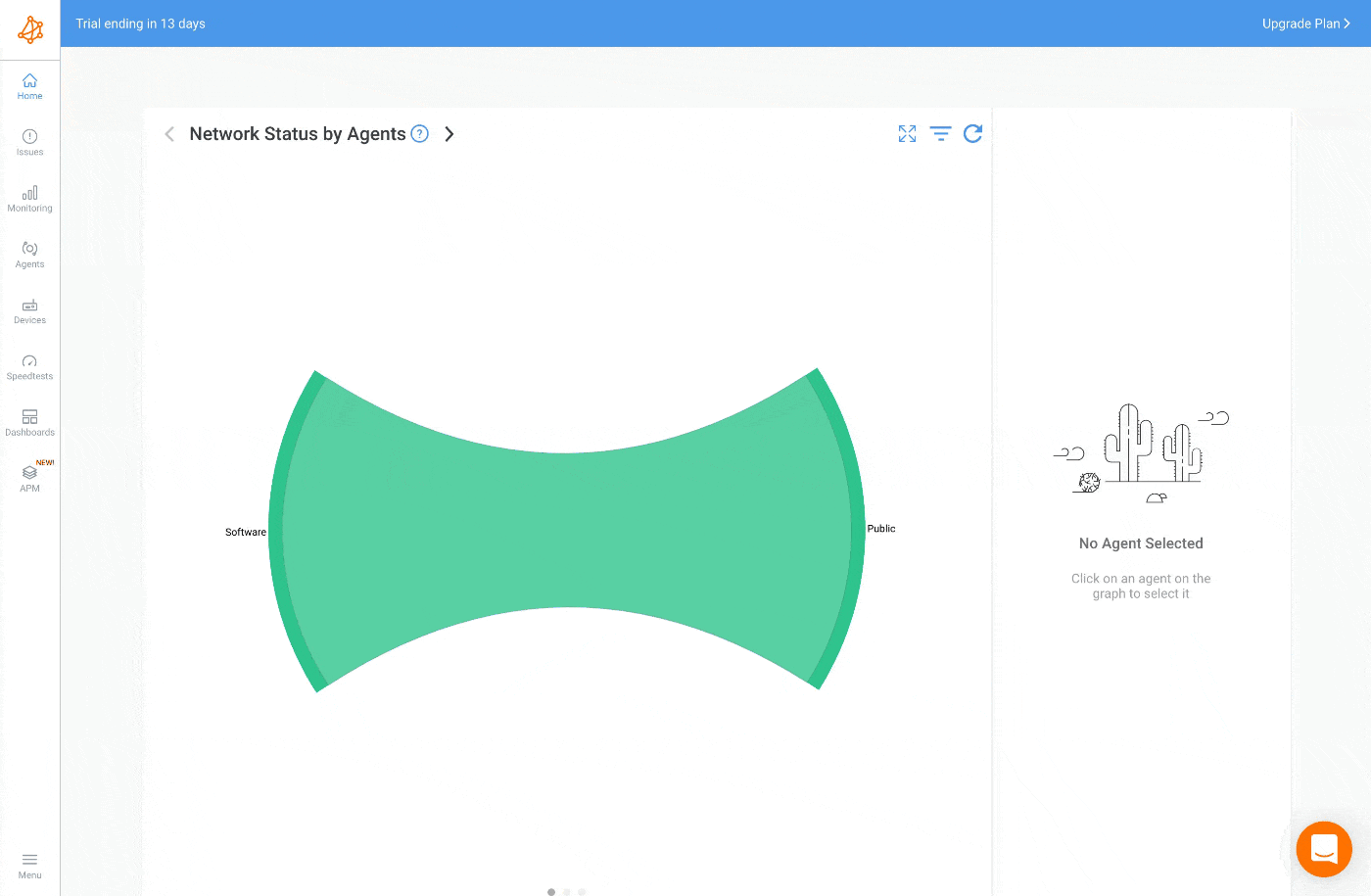
In addition to the metrics we just discussed above, there are a variety of other network metrics you should be analyzing when monitoring network usage. Let’s take a look:
- Top Talkers: Identifies the devices or applications generating the most network traffic. Helps in allocating resources efficiently and identifying potential bandwidth hogs.
- Application Usage: Monitors the usage patterns of different applications on the network. Enables prioritization of critical applications and aids in optimizing network resources.
- User Activity: Tracks the behaviour of users on the network. Facilitates user-specific optimizations and aids in troubleshooting user-related issues.
- Peak Usage Times: Identifies periods of high network activity. Allows for proactive resource allocation and capacity planning to handle peak demands.
Now, let's cut to the chase. In this section, we're getting down to brass tacks—analyzing traffic patterns and bandwidth consumption. Traffic patterns reveal the ebb and flow of data, providing valuable insights into the health and efficiency of your network.
Decoding Traffic Patterns: Unveiling the Flow of Data
Analyzing traffic patterns helps you understand how data traverses the digital landscape. This decoding process involves normalizing data flow, detecting anomalies, and optimizing routing to ensure a resilient and responsive network.
Normalization of Flow:
Establishing a network baseline for typical traffic patterns serves as a cornerstone for effective network management. Recognizing what constitutes normal allows for the swift identification of anomalies—abnormal spikes or unexpected drops in data flow. This proactive approach ensures that potential issues are addressed before they impact overall network performance.
Detection of Anomalies:
The ability to detect anomalies is a powerful tool in maintaining network security and efficiency. Unusual traffic patterns can be indicative of security threats, equipment malfunctions, or misconfigurations. By scrutinizing these patterns, IT professionals can swiftly identify and mitigate potential issues, ensuring the integrity and reliability of the network.
Optimizing Routing:
Efficient routing is a key outcome of traffic pattern analysis. Understanding how data naturally flows through the network allows for strategic optimization. Efficient routing minimizes latency, improves overall performance, and ensures that data takes the most direct path. The insights derived from traffic pattern analysis empower IT teams to optimize routing configurations, fostering a network that operates at its peak.
Bandwidth is the currency of digital exchange, and understanding its consumption is pivotal for maintaining optimal network performance. This unravelling process involves gaining insights into application-specific data usage, identifying peak usage times, and conducting protocol analysis for enhanced efficiency.
Application-Specific Insights:
Different applications have distinct bandwidth requirements. Analyzing bandwidth consumption on an application level allows for the prioritization of critical functions, ensuring that resources are allocated efficiently.
Peak Usage Identification:
Recognizing periods of high bandwidth consumption is essential for proactive network management. This insight enables IT professionals to allocate resources effectively and plan for capacity during peak demand, guaranteeing a smooth user experience.
Protocol Analysis for Efficiency:
Delving into network protocols unveils opportunities for optimization. Different protocols have varying data transmission efficiencies. Protocol analysis aids in fine-tuning network settings, mitigating potential bottlenecks, and enhancing overall network efficiency.
How to measure bandwidth, identify issues & optimize network performance. Use Obkio's Network Performance Monitoring tool for easy bandwidth monitoring.
Learn more

So now we understand what we have to analyze and measure to monitor network usage - but how exactly can you measure these metrics? You can’t do it yourself - but you can use a little help.
Network monitoring is not just a reactive measure to address issues as they arise; it is a proactive strategy that empowers IT professionals to understand, manage, and optimize network usage. It's the key to understanding, shaping, and optimizing how data flows through your network.
So how exactly does Network Monitoring optimize and monitor network usage?
Network monitoring tools continuously track and analyze network traffic in real-time. This constant surveillance provides immediate visibility into how resources are utilized and how data moves within the network.
At its core, network monitoring is about enhancing the end-user experience. By optimizing network usage, IT professionals contribute to a seamless and responsive digital environment. Users can access applications, services, and data without disruptions, fostering productivity and satisfaction.
So now we know that, when it comes to monitoring network usage, Network Monitoring solutions are the way to go. But how can you choose and implement the right tool for your business? We’ll give you a head start.
For businesses searching for an easy solution to monitor network usage and performance, Obkio's Network Performance Monitoring tool is the go-to choice.

Obkio's synthetic, end-to-end NPM tool simplifies the process of monitoring, troubleshooting, optimizing, and assessing network performance. Through the use of synthetic traffic for testing and simulating real-world scenarios, Obkio precisely measures critical network metrics, providing a no-nonsense approach to keeping your network in check.
By placing Network Monitoring Agents at various points within your network, Obkio ensures an ongoing exchange of synthetic traffic. This proactive approach enables constant monitoring of network performance, swiftly identifying any potential issues. Embrace the simplicity and precision of network usage measurements with Obkio's Network Performance Monitoring tool.

Obkio monitors network usage and network performance and end-to-end network performance and uses continuous synthetic traffic from Network Monitoring Agents deployed in key network locations like offices, data centers and clouds.
For your end-to-end network usage and performance monitoring setup, you’ll need the following Monitoring Agents (which Obkio’s Onboarding Wizard with help you deploy):
- Local Agents: Installed in the targeted office location where you want to monitor network usage and network performance. There are several Agent types available (all with the same features), and they can be installed on MacOS, Windows, Linux and more.
- Public Monitoring Agent: These are deployed over the Internet and managed by Obkio. They compare performance up to the Internet and quickly identify if the problem is global or specific to the destination. For example, measure network usage between your branch office and Google Cloud.

The Agents monitor key network metrics related to network usage and network performance by sending and monitoring synthetic traffic through your network every 500 ms for the most precise network performance measurements.
So when you’re looking to monitor network usage, you need visibility over your whole network. That means also activating Network Device Monitoring. It’s a fast and easy solution to get detailed information about the performance of your core network devices using SNMP polling to quickly and proactively pinpoint and troubleshoot network device issues like congestion, and high CPU usage and interface errors.
Network devices, including routers, switches, firewalls, and other infrastructure components, play a central role in managing and directing the flow of data within a network and are responsible for routing and forwarding data between different segments of the network. Monitoring these devices allows for the analysis of traffic patterns, helping to understand how data is moving within the network and identify any irregularities.
Monitoring network devices helps in tracking bandwidth utilization, identifying which devices or applications are consuming the most bandwidth, and optimizing resource allocation for efficient network usage. The performance of network devices also directly impacts the overall network performance. By monitoring devices, IT professionals can assess factors such as packet loss, latency, and throughput, gaining insights into the responsiveness and reliability of the network.
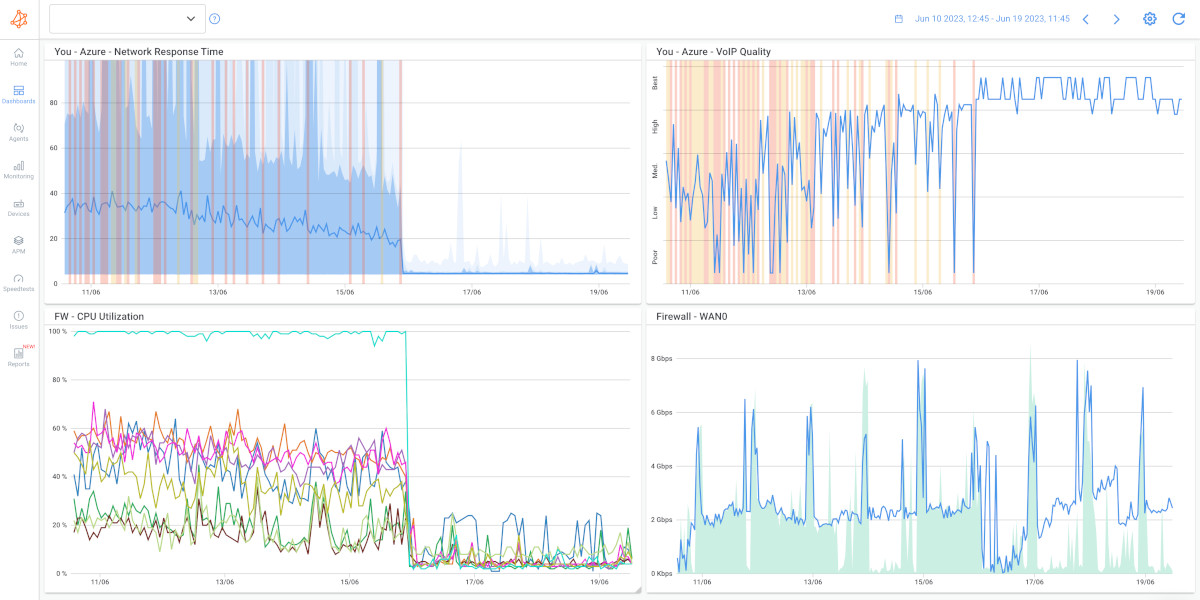
Here are some key network devices that should be monitored:
- Routers: Routers connect different network segments and facilitate the flow of data between them. Monitor bandwidth utilization, traffic patterns, interface status, and routing tables.
- Switches: Switches manage the local traffic within a network segment, improving overall network efficiency. Monitor network switch performance including port activity, VLAN performance, error rates, and switch capacity.
- Firewalls: Firewalls enforce security policies, controlling incoming and outgoing network traffic.
- Load Balancers: Load balancers distribute network traffic across multiple servers to ensure optimal resource utilization. Monitor server health, load distribution, and overall balancing efficiency.
- Access Points (APs) and Wireless Controllers: APs provide wireless connectivity, and controllers manage multiple APs in a wireless network. Monitor wireless network performance, client connections, signal strength, and interference.
- Gateways: Gateways connect different networks, serving as an entry/exit point between them. Monitor traffic passing through the gateway, protocol-specific metrics, and overall gateway performance.
- Proxy Servers: Proxy servers intercept and fulfill client requests for resources, improving security and performance. Monitor user access logs, bandwidth usage, and cache efficiency.
- VPN Concentrators: VPN concentrators handle the termination of VPN connections, providing secure communication over the Internet. Monitor VPN tunnel status, bandwidth usage, and security logs.
- DNS Servers: DNS servers resolve domain names to IP addresses, facilitating communication between devices. Monitor query performance, response times, and cache effectiveness.
Monitoring these network devices collectively provides a holistic view of network usage, allowing IT professionals to detect issues, optimize performance, and ensure the overall reliability and security of the network infrastructure.
Once you’ve deployed Obkio’s Network Monitoring solution, Obkio’s Monitoring Agents will then begin exchanging synthetic traffic with each other to continuously measure core network metrics from all ends of your network.
As we discussed earlier, there are a variety of network metrics that make us network usage monitoring, and give you an extensive view of your network performance, and any network issues affecting it. Out of those metrics, some of the most important that Obkio will help you keep an eye on include:
- Bandwidth Utilization: Measuring bandwidth usage indicates how much data is being transmitted over the network. This metric helps identify periods of high demand and potential congestion points.
- Throughput and Latency: Monitoring tools track throughput (actual data transfer rate) and latency (delay in data transmission). By analyzing these metrics, IT professionals can assess the efficiency and responsiveness of the network.
- Packet Loss: Monitor and identify instances of packet loss, where data packets do not reach their destination. Packet loss can impact the reliability of data transmission, and monitoring helps detect and address these issues promptly.
Obkio’s comprehensive network monitoring solution allows you to measure and analyze multiple metrics simultaneously, so you can assess network performance from various angles and proactively identify network problems at the earliest sign.
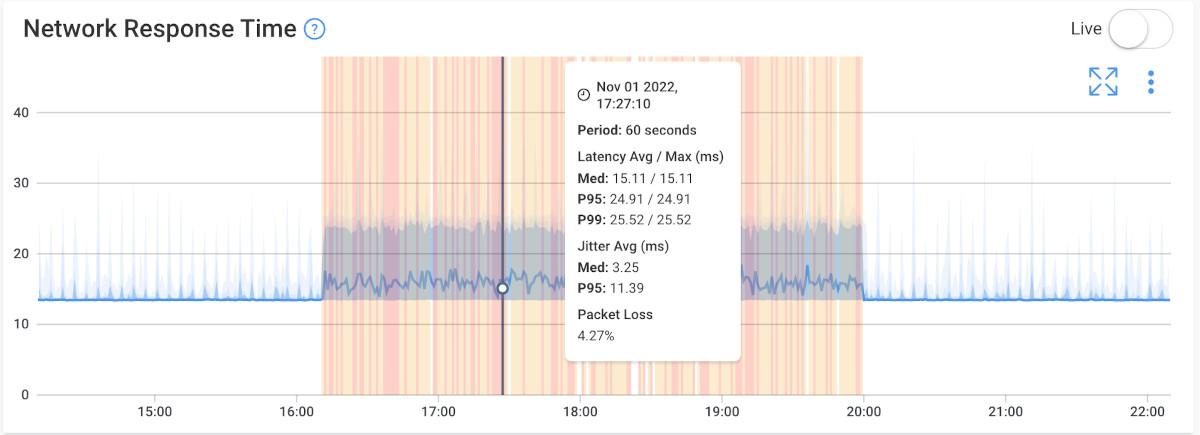
Understanding historical data is another essential aspect of monitoring network usage. Historical insights help in identifying trends, planning for capacity, establishing performance baselines, streamlining issue resolution, optimizing resource allocation, and ensuring policy compliance. By comparing current metrics to historical averages, IT professionals can quickly detect anomalies and address potential issues proactively.
Lucky for you, Obkio's Network Performance Monitoring tool allows you to monitor and analyze both real-time and historical data! Identify performance trends, plan for capacity requirements, and customize reports for in-depth analysis.
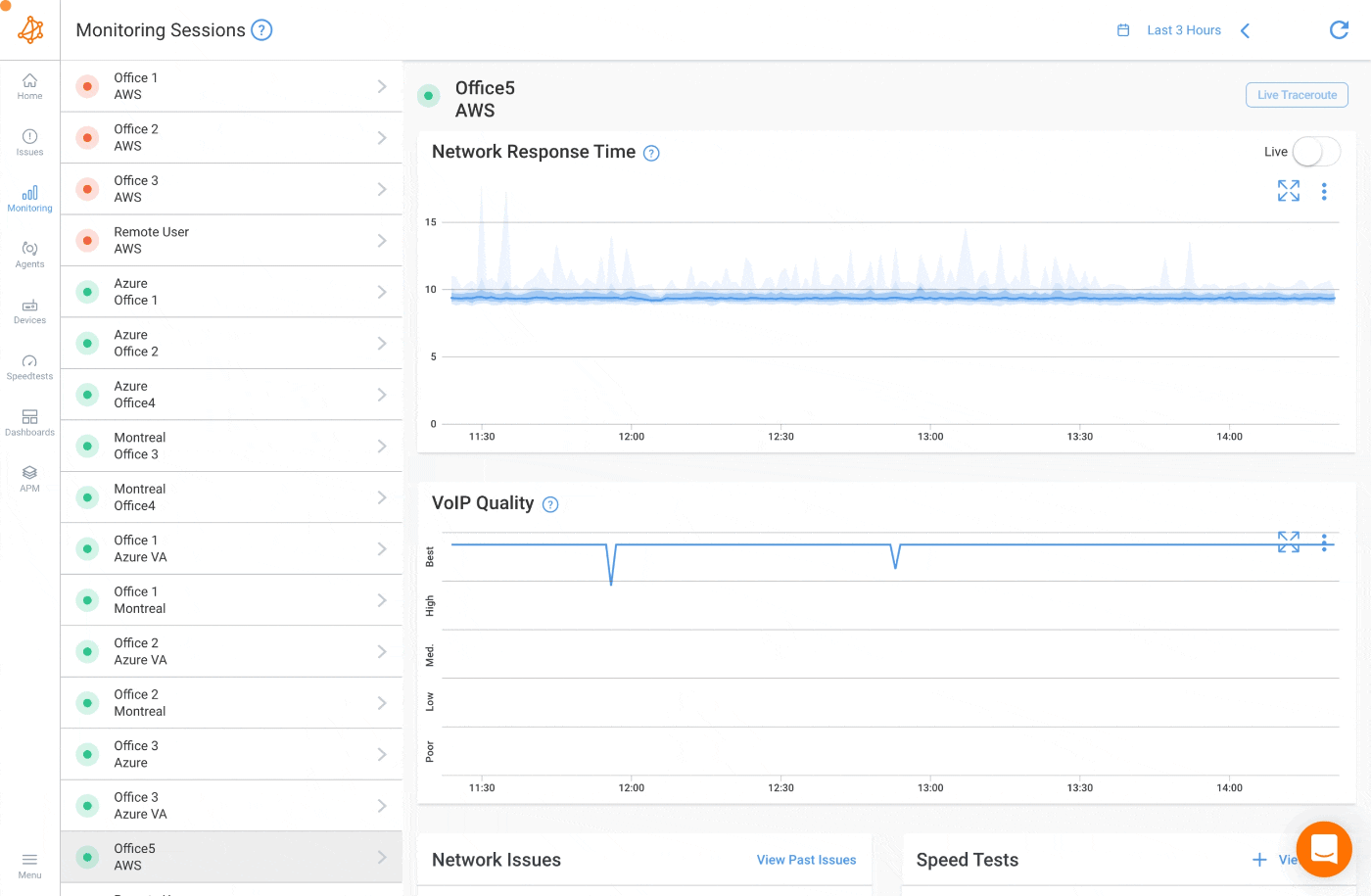
- Trend Analysis: Historical data allows IT professionals to identify patterns and trends in network usage over time. Recognizing trends helps in predicting future demands, planning for capacity, and proactively addressing potential issues before they impact performance.
- Capacity Planning: Historical data provides insights into the peak usage times and overall network capacity requirements. IT teams can plan for network expansion or upgrades based on historical usage patterns, ensuring that the infrastructure can handle increased demand without degradation in performance.
- Performance Baseline: Establishing a baseline of normal network behaviour is essential for detecting anomalies. Comparing current performance metrics to historical averages helps in quickly identifying deviations and potential issues, facilitating prompt troubleshooting.
- Issue Resolution: Historical data provides context for recurring network issues and their resolutions. IT professionals can refer to historical data to understand the impact of past issues, streamline the resolution process, and implement preventive measures.
With historical data analysis, Obkio empowers users to make informed decisions based on historical network data, ensuring a proactive and data-driven approach to network
Beyond providing real-time and historical data insights, Obkio excels in the implementation of advanced anomaly detection and alerting features. Users can tailor the tool to generate network monitoring alerts for specific anomalies, ensuring that deviations from normal network behaviour are promptly identified.
This proactive approach empowers IT professionals to respond promptly to potential issues, minimizing downtime and optimizing network performance.
The strength of Obkio's alerting mechanism lies in its ability to recognize not only traditional issues but also nuanced anomalies that might go unnoticed through conventional monitoring. By configuring alerts for unusual patterns or events, IT professionals using Obkio can stay one step ahead, addressing potential network challenges before they escalate.
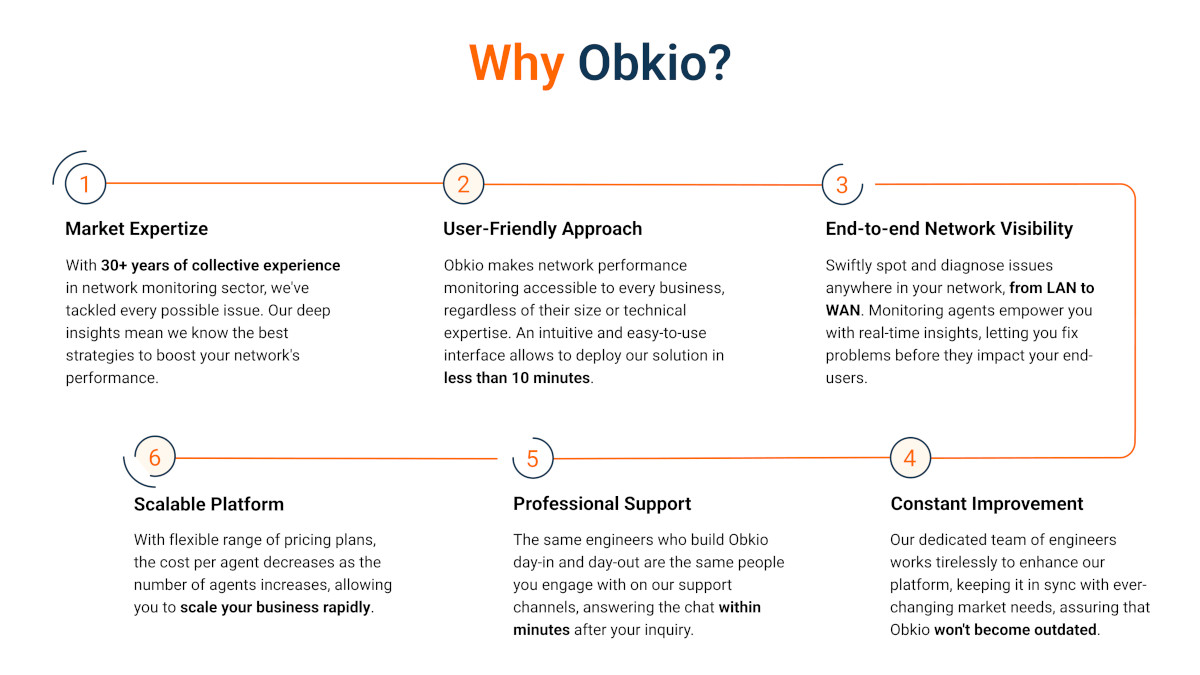

Comprehensively monitoring network usage involves scrutinizing both upload and download activities. Understanding the nuances of these different types of network usage is pivotal for maintaining optimal performance and addressing potential issues effectively.
Upload usage encapsulates the data transmission from an individual user's device to the broader network or the expansive realm of the Internet. This entails the act of sending data from a user's endpoint toward a destination, be it another user, a server, or a cloud-based service.
The significance of upload usage lies in its role as the initiator of data flow, allowing users to share, disseminate, and contribute content to the interconnected digital landscape.
Examples:
- Sending Emails
- Uploading Files to Cloud Storage
- Posting Content on a Website
Conversely, download usage entails the reception of data from the vast expanse of the network or the Internet onto an individual user's device. This involves the retrieval of information, content, or resources from remote servers or repositories, shaping the user's digital experience by providing access to a myriad of online offerings.
Examples:
- Accessing Web Pages
- Downloading Files
- Streaming Media Content
Understanding the dynamics of both upload and download usage is foundational for effective network management. It allows for the optimization of resources, ensures equitable distribution of bandwidth, and facilitates a harmonious coexistence of diverse online activities, contributing to an enhanced digital experience for users.
Monitoring both upload and download network usage types is akin to wielding a complete set of tools for network oversight. This dual-focused approach not only ensures a well-balanced and efficient network but also empowers IT teams to proactively address challenges, optimize resources, and uphold the integrity of the digital infrastructure.
- Balancing Network Traffic: Monitoring both upload and download usage ensures an equitable distribution of network traffic. It prevents one-directional congestion, minimizes latency, and fosters a harmonious coexistence of activities, facilitating a seamless user experience.
- Identifying Bandwidth Hogs: Some applications or devices may disproportionately consume either upload or download bandwidth. By scrutinizing both types of usage, network administrators can pinpoint bandwidth-intensive applications or devices, allowing for equitable resource allocation and preventing bottlenecks.
- User Experience Optimization: Understanding the nature of upload and download activities is crucial for tailoring the network to meet diverse user demands. By analyzing both usage directions, IT professionals can optimize network configurations to enhance the overall user experience, ensuring smooth interactions with various applications and services.
- Troubleshooting Efficiency: When network issues arise, insights into both upload and download usage expedite the troubleshooting process.IT professionals can quickly discern the direction of problematic traffic, facilitating targeted solutions and minimizing downtime, thus optimizing network performance.
Various factors can influence network usage patterns and potentially lead to performance hiccups. Understanding these elements is crucial for maintaining a resilient and efficient network infrastructure. Additionally, your Network Monitoring tool is your key to identifying and troubleshooting these network usage bottlenecks, before they turn into full-fledged issues.
In this section, we'll explore the common factors that can affect network usage and delve into how they might contribute to performance issues.
Several factors can impact network usage and potentially lead to performance issues.
1. Bandwidth Saturation:
When the available bandwidth is fully utilized, it can lead to congestion and slow down network performance. This includes reduced data transfer speeds, latency issues, and potential service disruptions.
2. Network Congestion:
High levels of simultaneous data traffic, often caused by too many devices competing for limited network resources can lead to network congestion. This can cause sluggish performance, increased latency, and potential packet loss throughout your entire network.
3. Hardware Limitations:
Outdated or insufficient network hardware, such as routers, switches, or network interface cards, may not be able to support the required data throughput in your network. This can lead to network bottlenecks, slow data transfer, and overall network inefficiency.
4. Software or Firmware Issues:
Bugs, glitches, or outdated software/firmware in network devices can lead to operational issues throughout your network. This can cause unpredictable network behaviour, instability, and potential vulnerabilities.
5. Security Threats and Attacks:
Malware, viruses, or cyberattacks can compromise network integrity, causing increased traffic or denial of service, network slowdowns, data breaches, and service disruptions.
6. Packet Loss:
Loss of data packets during transmission, often due to network congestion, hardware issues, or interference. Measuring packet loss is important to avoid degraded voice/video quality, increased retransmissions, and reduced overall network performance.
7. Latency:
Delay in the transmission of data between source and destination. Measuring latency is key to avoiding slower response times, especially critical for real-time applications like video conferencing or online gaming.
8. Jitter:
Variability in the arrival time of data packets, leading to inconsistent packet delivery. Measuring jitter is especially important for avoiding disrupted audio/video quality in real-time applications.
9. Network Configuration Issues:
Incorrect or suboptimal configuration settings in routers, switches, or firewalls. This can lead to suboptimal routing, miscommunication, and potential security vulnerabilities.
10. Overutilization of Resources by Applications:
Certain applications or services may consume excessive network resources and lead to overutilization. Competing for bandwidth can lead to performance degradation for other applications.
Effective network management involves addressing these factors through proactive monitoring, regular maintenance, and adopting scalable and up-to-date hardware and software solutions. Utilizing tools like Obkio's Network Performance Monitoring can contribute significantly to identifying and resolving network usage issues before they impact overall performance.
Learn how to identify network issues by looking at common problems, causes, consequences and solutions.
Learn more

Understanding the nuances between high and low network usage is fundamental for efficient network optimization since they can drastically affect network performance in different ways. High network usage, marked by intensive data transfer and potential congestion, requires proactive measures to maintain optimal performance and user experience. Recognizing periods of low network usage is equally crucial, offering opportunities for efficient resource allocation and potential cost savings.
- Intensive Data Transfer: High network usage is characterized by a substantial volume of data being transmitted across the network.
- Elevated Bandwidth Consumption: Applications or activities generating high usage often consume a significant portion of available bandwidth.
- Increased Latency: Heavy network traffic can lead to elevated latency, causing delays in data transmission and response times.
- Potential Congestion: High network usage may result in WAN or LAN congestion, leading to slower data transfer speeds and potential service disruptions.
Implications:
- Performance Degradation: Users may experience slower internet speeds and delays in accessing online services.
- Risk of Bottlenecks: Intensive usage can create bottlenecks, impacting the overall efficiency of the network.
- Quality of Service (QoS) Challenges: Applications requiring low latency, such as real-time communication tools, may face quality challenges.
Considerations:
To navigate high network usage effectively, IT professionals need to prioritize critical applications, engage in proactive capacity planning, and deploy robust monitoring tools with real-time alerts.
- Sparse Data Transmission: Low network usage involves minimal data transmission across the network.
- Underutilized Bandwidth: A significant portion of available bandwidth remains unused during periods of low network usage.
- Low Latency: With fewer concurrent activities, latency tends to be lower during periods of low usage.
- Potential for Resource Underutilization: Network resources, such as bandwidth and processing power, may be underutilized.
Implications:
- Resource Efficiency: Low network usage can contribute to efficient resource utilization, allowing for optimal performance.
- Potential for Cost Optimization: Organizations may explore cost-saving measures related to bandwidth during periods of consistently low usage.
Considerations:
To leverage the benefits of low network usage, IT professionals can explore dynamic resource allocation mechanisms and assess the need for scaling down network resources during extended periods of low usage.
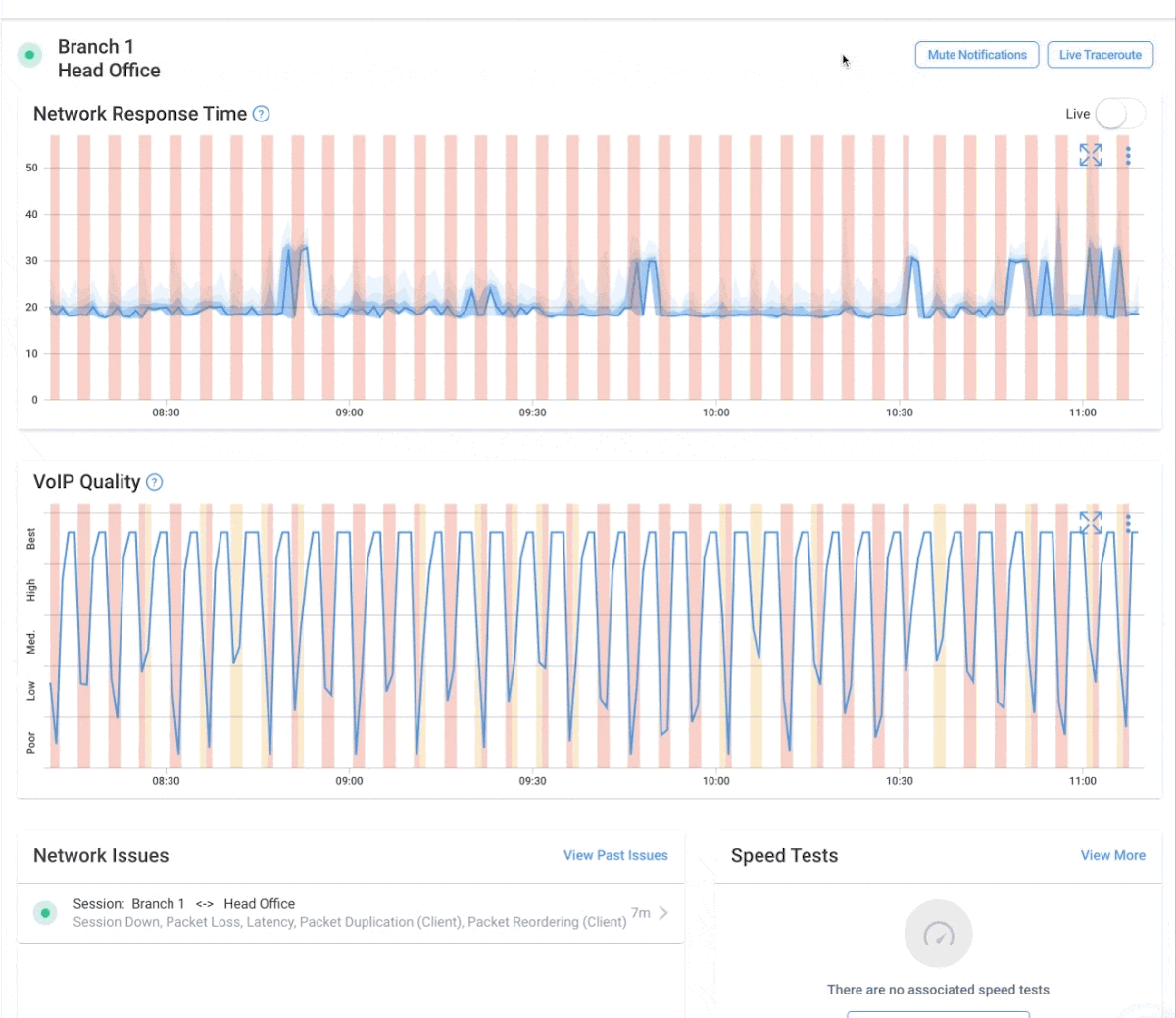

As we wrap up our exploration of monitoring network usage, here are some practical tips to keep in your arsenal. From prioritizing critical traffic to leveraging scalable infrastructure, these final insights serve as your guide to fostering a network that not only meets current demands but is also primed for the challenges ahead. Let's delve into these essential tips for network usage and performance optimization!
Traffic prioritization involves giving preference to certain types of data over others. This ensures that critical applications, like video conferencing or VoIP, receive sufficient bandwidth to operate smoothly, preventing them from being hindered by less time-sensitive data.
Think of your network as a busy highway. Prioritize the important vehicles (critical applications) to ensure they have a smooth and fast lane, avoiding traffic jams.
Quality of Service (QoS) settings allow you to assign priorities to different types of traffic on your network. By doing so, you ensure that high-priority applications receive preferential treatment, experiencing lower latency and fewer disruptions compared to less critical data.
Leverage QoS settings to allocate network resources based on application priority, ensuring that essential applications receive preferential treatment.
Think of bandwidth management tools as traffic cops for your network. They ensure that no single car (device or application) hogs the road, keeping the flow smooth and fair for everyone.
Bandwidth management tools control the flow of data, preventing any single device or application from monopolizing the available bandwidth. This helps maintain a fair and efficient distribution of resources.
Content Delivery Networks (CDNs) consist of distributed servers that store cached content closer to end-users. This minimizes latency and accelerates the delivery of web pages, images, and other content, resulting in faster loading times and a better user experience.
CDNs are like having local branches of your favorite store everywhere. They bring the products (web content) closer to you, reducing the travel time and making your shopping experience faster.
Compression reduces the size of data files before transmission, optimizing bandwidth usage. It's like squeezing the air out of a suitcase before a trip, making it more efficient and faster to transport, especially beneficial for large files and data transfers.
Regular updates to network hardware (routers, switches) and software (firmware, operating systems) are essential for security, performance improvements, and compatibility with the latest technologies. Updates keep your network infrastructure running smoothly and efficiently.
Imagine your network is a well-oiled machine. Regular updates are like giving it a tune-up, ensuring all parts work smoothly and efficiently.

Explanation: Network protocols are the rules governing data exchange between devices. Optimizing protocols involves selecting those that are efficient and suited to your network's needs, minimizing unnecessary overhead and maximizing data transfer efficiency.
Load balancing is your traffic manager. It involves distributing network traffic across multiple servers to prevent any single server from being overwhelmed. It ensures even distribution of the workload, optimizing resource usage and preventing bottlenecks.
Network traffic monitoring involves continuously observing data patterns, identifying anomalies, and proactively addressing potential issues. This real-time insight allows for efficient troubleshooting, ensuring a responsive and reliable network.
It helps you see where congestion is building up, allowing you to deploy solutions before it turns into a full-blown traffic jam.
Caching is like having a quick-access shelf in your pantry. It stores frequently used items, so you don't have to go to the store (server) every time you need them, saving time and effort.
Caching stores frequently accessed data closer to end-users, reducing the need to fetch it from the original source every time. This minimizes latency and speeds up data retrieval, improving the overall responsiveness of applications and services.
Network segmentation involves dividing a network into smaller, isolated segments. This prevents certain types of traffic from affecting others, enhancing security, and optimizing the flow of data within each segment.
DNS resolution involves converting human-readable domain names into IP addresses. It’s like having a speedy GPS. It quickly finds the best route (IP address) to your destination (website), ensuring you reach your online spots without unnecessary detours.
Optimizing this process ensures quick and efficient address resolution, reducing the time it takes to access websites and services.
The journey to optimal network usage is both intricate and rewarding. By understanding the nuances of high and low usage, adopting network monitoring best practices, and embracing proactive management, you've equipped yourself with the knowledge to steer your network towards efficiency and resilience.
As you embark on implementing these insights, remember that real-time monitoring is the compass guiding your way.
For a seamless and comprehensive solution, consider incorporating Obkio's Network Performance Monitoring tool into your arsenal. With its synthetic testing, precise metrics, and proactive approach, Obkio ensures that your network not only performs optimally but also evolves with the ever-changing demands of the digital landscape.

Embark on a new era of network management—precise, proactive, and poised for the future. Elevate your network's performance with Obkio. Take the first step toward seamless connectivity. Explore Obkio's Network Performance Monitoring tool today. Your network's next level awaits
- 14-day free trial of all premium features
- Deploy in just 10 minutes
- Monitor performance in all key network locations
- Measure real-time network metrics
- Identify and troubleshoot live network problems













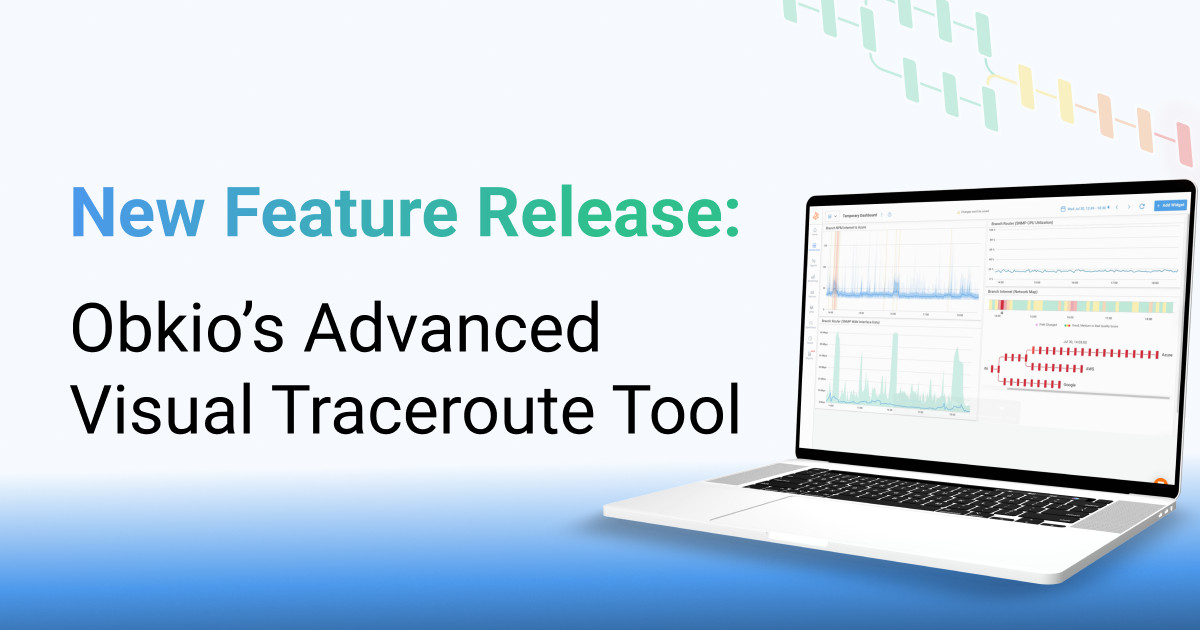













 Obkio Blog
Obkio Blog





